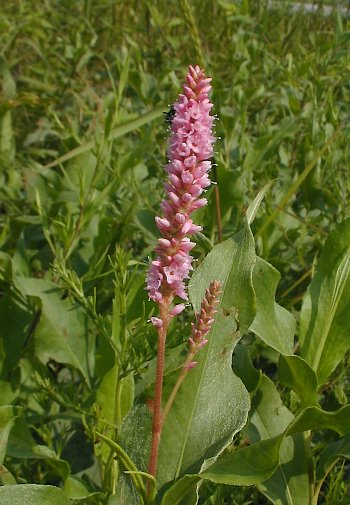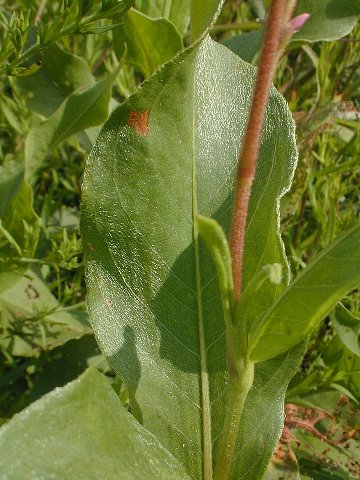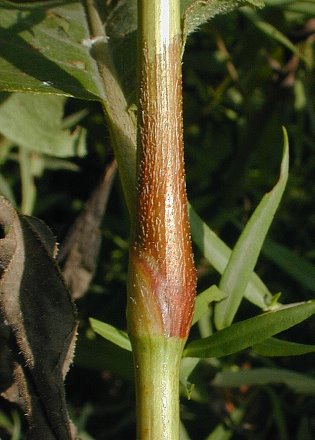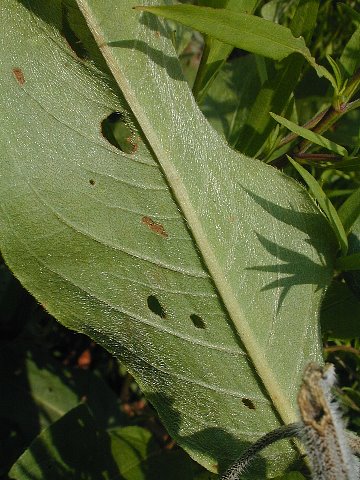Description: This perennial plant is about 2–3½' tall and either unbranched or sparingly branched. The central stem is more or less erect (for terrestrial plants), swelling somewhat at the nodes where the leaf-sheaths wrap around the stem. These nodes can be brownish and short-hairy, but they lack bristles at the edges. Otherwise, the central stem is light green, terete, and glabrous to silky-hairy. The alternate leaves are up to 8" long and 3" across; they have short petioles. The leaves are usually lanceolate or ovate in shape, while their margins are smooth. Sometimes the margins are undulate (up-and-down) or slightly curled. Both the upper and lower leaf surfaces are medium green. The leaf surfaces are either hairless, or they have appressed silvery hairs, depending on the local ecotype. The midveins on leaf undersides are quite prominent.

Their are 1 or 2 terminal racemes of flowers at the apex of the central stem. The flowering stalks are quite hairy and often brownish in appearance. The cylindrical racemes are about 2-3" long and densely crowded with flowers. Each flower is about 1/6" (4-5 mm.) across, consisting of 5 petaloid sepals, 5 exerted stamens, and an ovary with a divided white style. The showy sepals of these flowers are rosy pink or scarlet (usually the former). The blooming period can occur from mid-summer to early fall, lasting about 1-2 months for a colony of plants. There is no noticeable floral scent. Usually, only a minority of plants in a colony will bloom during a given year. The flowers are replaced by black seeds that are ovoid to globoid in shape and somewhat flattened; the seed surface is shiny and minutely granular. The root system produces long rhizomes, from which colonies of plants are formed.

Cultivation: The preference is full sun, wet conditions where flooding occasionally occurs, and soil containing loam or silt. This plant will grow in shallow water, where it will assume a more aquatic habit and form, but it can also grow in soil that is steadily moist. It does not tolerate drought. Scarlet Smartweed can spread aggressively to form large colonies in wet areas. Unlike most smartweeds (Persicaria spp.), it has a perennial habit.

Range & Habitat: The native Scarlet Smartweed occurs occasionally in most counties of Illinois; it is less common or absent in southern Illinois, preferring the poorly drained glaciated areas of the state (see Distribution Map). Habitats include wet prairies, prairie swales, sloughs, marshes, swamps, low areas along ponds and streams (including areas with shallow water), and ditches along roadsides and railroads. Scarlet Smartweed can be found in wetland areas where Iris virginica shrevei (Southern Blue Flag) and Spartina pectinata (Prairie Cordgrass) also occur. It can be found in either disturbed or higher quality habitats.

Faunal
Associations:
The flowers attract many insect visitors, including bumblebees and
other long-tongued bees, Halictid bees and other short-tongued bees,
Sphecid wasps, Vespid wasps, spider wasps, Syrphid flies and other
flies, butterflies, skippers, and moths. These insects suck nectar
primarily. Insects that feed on the foliage and other parts of
smartweeds (Persicaria
spp.)
include flea beetles (Disonycha spp.), weevils (Tyloderma spp.), plant
bugs, stink bugs, aphids, larvae of sawflies (Ametastegia spp.),
grasshoppers (Paroxyna spp.), larvae of the butterflies Lycaena
helloides (Purplish Copper) and Lycaena hyllus
(Bronze Copper), and larvae Pseudeustrotia carneola (Pink-barred Pseudeustrotia) and other moths (see Insect
Table). The seeds of smartweeds are a popular source of food
to many
songbirds, while the seedheads are eaten by waterfowl (see Bird Table).
Mammalian herbivores usually don't consume smartweeds to any great
extent because of the peppery/bitter taste of their leaves, although
White-tailed Deer sometimes chomp off the tender tops of plants, while
Canada Geese sometimes yank off the floral spikes.
Photographic Location:
The photographs were taken of plants growing in a flood-prone area of a
moist remnant prairie, which was located between a road and an
abandoned railroad in Champaign County, Illinois.

Comments: Scarlet Smartweed is my favorite smartweed because of its beauty. The leaves often shimmer in the sunlight because of their silky hairs, while the individual flowers are rather large for a smartweed and quite colorful. Recently, the smartweeds have been separated from the knotweeds by taxonomists and assigned to the Persicaria genus. Formerly, Scarlet Smartweed has been assigned such scientific names as Polygonum coccineum, Polygonum amphibium var. emersum, and Polygonum muhlenbergii. Sometimes Scarlet Smartweed is lumped together with Polygonum amphibium (Water Smartweed), but these are quite different species, the latter having flowering racemes that are more short and cone-shaped, rather than cylindrical. Scarlet Smartweed can be distinguished from other smartweeds by its large size, erect racemes of colorful flowers, and the presence of conspicuous hairs on the flowering stalks and leaf-sheaths. Another common name of this species is Marsh Smartweed.